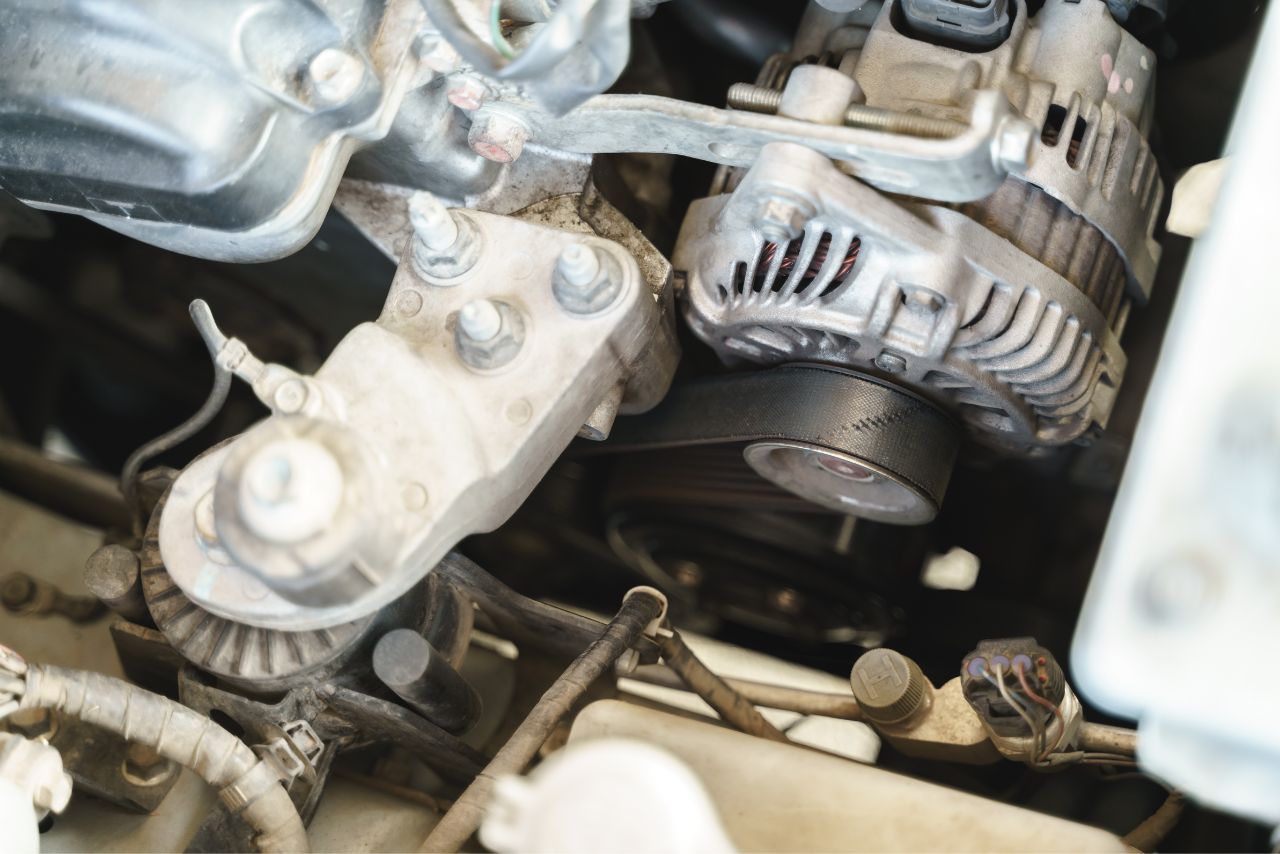If you’re a proud owner of a Fiat 500, then you must be aware of the importance of maintaining its engine.
One of the most crucial parts that need to be checked regularly is the cambelt.
In this post, we’ll discuss the Fiat 500 cambelt interval, so you can keep your car running smoothly and avoid any potential engine damage.
During the research I found that the officials recommend to change the Cambelt every 155,000 miles or 9 years, but I would highly recommend you to change your Cambelt after 60,000 miles or every five years which is mostly beneficial for car performance according to personal experience.
Table of contents
What is a Fiat 500 Cambelt?
If you own a Fiat, it is essential to know about the cambelt interval. The cambelt is a crucial component in your vehicle that synchronizes the rotation of the camshaft and crankshaft, allowing the engine to function efficiently.
The cambelt, also known as a timing belt, needs to be replaced at regular intervals to prevent it from breaking, which can cause severe engine damage.
The cambelt interval varies depending on the model and year of your Fiat.
It is generally recommended to replace the cambelt every 60,000 miles or every five years, whichever comes first.
It is important to follow the manufacturer’s recommended cambelt interval to ensure your Fiat runs smoothly and avoid expensive repairs.
If you are unsure about when to replace your cambelt, consult your Fiat owner’s manual or speak to a qualified mechanic.
Why is Fiat 500 Cambelt Interval important to change your cambelt?
It is imperative to change your cambelt at the recommended intervals to avoid costly damage to your engine.
The cambelt, or timing belt, is a crucial component that synchronizes the rotation of the crankshaft and camshaft.
Over time, the cambelt can become worn or damaged, leading to a loss of synchronization and potentially causing catastrophic engine failure.
Most manufacturers recommend changing the cambelt between 60,000 and 100,000 miles, depending on the make and model of your vehicle.
Ignoring this maintenance can result in bent valves, damaged pistons, and in some cases, a complete engine replacement.
It is important to have your cambelt inspected regularly and replaced according to the manufacturer’s recommendations.
Don’t neglect this important maintenance task, as it can save you thousands of dollars in repairs and ensure the longevity of your engine.
Mention of the importance of replacing the cambelt on time to avoid engine damage.
- 1. The cambelt, also known as the timing belt, is a crucial component in your engine that synchronizes the movement of the crankshaft and camshaft.
- 2. Replacing the cambelt on time is essential to avoid engine damage, as a broken or worn cambelt can cause the pistons and valves to collide, resulting in costly repairs or even engine replacement.
- 3. The replacement interval for cambelts varies depending on the make and model of your vehicle, but most manufacturers recommend replacing it every 60,000 to 100,000 miles or every 5 to 7 years, whichever comes first.
- 4. It’s important to follow the manufacturer’s recommended replacement interval, even if your cambelt looks fine, as it can deteriorate from the inside and fail unexpectedly.
- 5. Getting your cambelt replaced by a qualified mechanic is crucial, as it requires specialized tools and knowledge to ensure proper installation and tensioning.
- 6. In addition to replacing the cambelt, it’s also a good idea to replace other components that are typically replaced at the same time, such as the water pump, tensioner, and idler pulleys, to avoid future problems and save on labor costs.
When should you change your cambelt?

According to my research I recommend replacing the cambelt between 60,000 and 100,000 miles, depending on the make and model of the car.
The cambelt, also known as the timing belt, is responsible for synchronizing the engine’s various components, such as the crankshaft and camshaft, to ensure they operate in harmony.
If the cambelt snaps, it can cause significant damage to the engine, resulting in costly repairs. However, it’s vital to check your car’s owner’s manual to determine the recommended interval for your specific vehicle.
Additionally, if you notice any signs of wear and tear on the cambelt, such as cracks or frayed edges, it’s crucial to have it checked by a mechanic and replaced if necessary.
Don’t risk damaging your engine – make sure you replace your cambelt on time.
How often should you change your cambelt?
As The general rule of thumb is to replace the cambelt every 60,000 to 100,000 miles, depending on the manufacturer’s recommendations.
However, it is essential to note that some vehicles may require replacement at shorter intervals, such as 40,000 miles.
It is crucial to check the owner’s manual or consult a professional mechanic to determine the recommended replacement interval for your specific vehicle.
Neglecting to replace the cambelt can lead to costly repairs, including engine replacement, so it is crucial to stay on top of this maintenance task. Remember, prevention is always better than cure.
What are the consequences of not changing your cambelt?

1. Engine failure:
The most severe consequence of not changing your cambelt is engine failure. Over time, the cambelt can become worn and stretched, which can cause it to snap.
If this happens while you’re driving, it can cause significant damage to your engine and may even render it useless.
2. Costly repairs:
If your cambelt snaps and causes engine damage, you can expect to pay a hefty repair bill. In some cases, it may be more cost-effective to replace the entire engine rather than repair it.
3. Reduced performance:
A worn cambelt can cause your engine to run less efficiently, which can result in reduced performance and lower fuel economy.
If you notice your car isn’t accelerating or running as smoothly as it used to, a worn cambelt could be the culprit.
4. Safety risks:
A snapped cambelt can cause your engine to stop abruptly, which can be dangerous if you’re driving at high speeds or in heavy traffic. In some cases, it may even cause you to lose control of your vehicle.
5. Inconvenience:
If your cambelt snaps, you’ll be stranded until your car can be towed and repaired. This can be a major inconvenience, especially if you rely on your car for work or other important activities.
How much does it cost to change your cambelt?
In general, the cost can range from around $300 to $1000. It’s important to keep in mind that the cambelt, also known as the timing belt, is a crucial component of your engine that helps keep it running smoothly.
If the cambelt fails, it can cause serious damage to your engine and result in costly repairs. Therefore, it’s recommended that you have it replaced every 60,000 to 100,000 miles, or as specified in your vehicle’s owner’s manual.
While the cost may seem steep, it’s a necessary investment in the longevity and health of your car. Be sure to consult with a trusted mechanic to get an accurate estimate for your specific vehicle.
Can you change a Cambelt yourself?
In general, yes, you can change a cambelt yourself , but it’s not recommended unless you have experience and the proper tools.
Replacing a cambelt can be a complicated and time-consuming process that requires specialized knowledge to ensure proper installation and tensioning.
If you make a mistake, it could lead to costly engine damage, which is why it’s crucial to have a qualified mechanic handle the job.
However, if you’re confident in your abilities and have access to the necessary tools, you can save some money by doing it yourself.
Just be sure to follow the manufacturer’s recommended replacement interval and replace any other components that typically need changing at the same time, such as the water pump, tensioner, and idler pulleys.
How do you change your cambelt?
- 1. First, disconnect the battery and make sure the engine is cool.
- 2. Remove any exterior covers or parts blocking access to the cambelt.
- 3. Use a timing belt tensioner tool to loosen the tension on the belt.
- 4. Remove the old cambelt and inspect the pulleys and tensioner for wear or damage.
- 5. Install the new cambelt by following the manufacturer’s recommended routing and tension specifications.
- 6. Use the timing belt tensioner tool to adjust the tension on the new belt.
- 7. Reinstall any exterior covers or parts that were removed.
- 8. Reconnect the battery and start the engine to ensure proper operation.
What are the signs that your cambelt needs changing?
“5 Signs Your Cambelt Needs Changing:
| Consequence | Description |
|---|---|
| Engine damage | The most serious consequence of not changing your cambelt is engine damage. If the cambelt breaks, it can cause the pistons and valves to collide, which can destroy the engine. |
| Engine misfires | If the cambelt is not properly timed, it can cause the engine to misfire. This can lead to poor fuel economy, decreased performance, and increased emissions. |
| Rough idlingIf the cambelt is not properly timed, it can cause the engine to idle rough. This can be a sign of more serious problems, such as engine misfires or damage. | |
| Squealing noise | A squealing noise from the engine can be a sign that the cambelt is worn or loose. This is a sign that the cambelt needs to be replaced as soon as possible. |
| Engine overheating | If the cambelt is not properly timed, it can cause the engine to overheat. This can lead to serious damage to the engine, such as warped head gaskets and cracked pistons. |
| Loss of powerIf the cambelt is not properly timed, it can cause the engine to lose power. This can make it difficult to accelerate and can lead to poor fuel economy. | |
| Increased emissions | If the cambelt is not properly timed, it can cause the engine to emit more pollutants. This can lead to fines from the government and can damage the environment. |
1. Strange noises:
If you hear a high-pitched whining noise coming from the engine, it could be a sign that your cambelt is worn and needs replacing.
2. Engine misfires:
A worn cambelt can cause your engine to misfire or run poorly. If you notice that your car is struggling to start or feels sluggish while driving, it’s time to get your cambelt checked.
3. Oil leaks:
Cambelts are usually covered with a plastic or metal casing, but if you notice oil leaks around the timing belt cover, it could be a sign of a worn or damaged cambelt.
4. Visible wear:
If you can see visible signs of wear on your cambelt, such as cracks, fraying, or missing teeth, it’s time to replace it.
5. Mileage:
Most manufacturers recommend replacing the cambelt every 60,000 to 100,000 miles. If you’re approaching that mileage, it’s a good idea to have your cambelt inspected and replaced if necessary.”
Can you drive with a broken cambelt?
If you suspect that your car’s cambelt has broken, it’s important to avoid driving your vehicle as much as possible.
In fact, if the cambelt has snapped while you’re driving, it’s recommended that you stop the engine immediately and call a mechanic.
Driving with a broken cambelt can cause serious damage to the engine, and in some cases, it can even lead to a total engine failure.
The cambelt is responsible for synchronizing the engine’s valves and pistons, and if it breaks, the two can collide and cause significant damage.
Attempting to drive with a broken cambelt can also cause other issues, such as loss of power, increased fuel consumption, and difficulty starting the vehicle.
According to my research, it’s never a good idea to drive with a broken cambelt, so if you suspect that this component has failed, it’s best to have it inspected and repaired by a professional mechanic as soon as possible.
How to avoid a broken cambelt?
To avoid a broken cambelt, it’s essential to understand what it is and why it’s important.
A cambelt, also known as a timing belt, is a vital component of your car’s engine. It controls the timing of the engine’s valves, ensuring that they open and close at the correct time.
A broken cambelt can cause serious damage to your engine, and even render it irreparable. To avoid this, it’s crucial to follow your car manufacturer’s recommended cambelt replacement schedule.
This typically ranges from every 60,000 to 100,000 miles, but can vary depending on the make and model of your car.
It’s also important to have your cambelt inspected regularly by a qualified mechanic, especially if you notice any signs of wear or damage.
By taking these simple precautions, you can help ensure the longevity and reliability of your car’s engine, and avoid the costly repairs that come with a broken cambelt.
- 1. Follow the manufacturer’s recommended cambelt replacement interval. This can vary depending on the make and model of your vehicle, but typically ranges from 60,000 to 100,000 miles.
- 2. Pay attention to warning signs such as unusual noises or vibrations coming from the engine, difficulty starting the vehicle, or poor performance. These could be signs that your cambelt is wearing out and needs to be replaced.
- 3. Regularly check the condition of your cambelt and other related components such as tensioners and pulleys. Look for signs of wear, cracking, or fraying, and replace them as necessary.
- 4. Avoid driving in extreme conditions such as hot temperatures or stop-and-go traffic, as this can put additional stress on your cambelt and cause it to wear out more quickly.
- 5. Have your vehicle serviced by a reputable mechanic who is experienced in cambelt replacement and maintenance. They can help you identify any potential issues and ensure that your cambelt is replaced according to the manufacturer’s specifications.
Conclusion and final thoughts 💭
The Fiat 500 Cambelt Interval is a crucial that needs to be checked regularly to avoid any potential engine damage.
It’s recommended to replace the cambelt at the recommended intervals to keep your car running smoothly.
If you notice any signs of a worn-out cambelt, don’t delay in getting it replaced to avoid costly repairs.
Latest Posts:
- Can WD-40 Remove Scratches on Cars? (Hint: Yes, but…)
- Can You Use a Drill to Polish Your Car? (We Tried it Out!)
- Should You Cover Car Scratches With Stickers? (REVEALED!)
- Buick Service Stabilitrak: (Causes & 100% Guaranteed Fix!)
- Common Holden Trax Problems (Causes & 100% Proven Fixes!)
- Jeep Commander Transmission Over Temp: (Guaranteed Fix!)











Leave a Reply